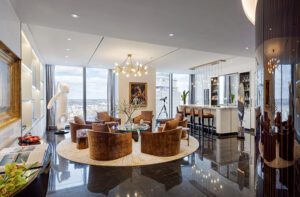Encore Performance
July 19, 2011
Text by Nena Donovan Levine Photography by Robert Preston
In 1974, Robert Preston, an award-winning concert pianist, met Paul Caponigro, a renowned photographer. Preston had taken up photography in his teens, entranced by The Eloquent Light, a biography of Ansel Adams, and he had asked Caponigro to comment on his work. The seasoned photographer looked over Preston’s images and said, “Boy, are you in trouble.”
Caponigro recognized Preston’s photographic talent and—because he had also trained as a pianist—knew the demands imposed by the dueling Muses. Relaxing now in his Stamford studio, where his dramatic black-and-white prints grace the walls, Preston recalls his mentor’s wisdom. As Caponigro predicted, balancing two intense passions would prove challenging. Although Preston found deep satisfaction in photography, his grueling practice and performance schedule didn’t allow much time behind the lens.
Eventually, despite his Juilliard training and many awards, including a gold medal in the prestigious Busoni competition, he cast his lot with photography, joining a long line of musicians-turned-visual artists. In fact, Preston’s career took a path not unlike that of Ansel Adams, his earliest role model. Adams, too, had practiced both arts, pursuing a career as a concert pianist until he was nearly thirty. Alluding to his musical past, the famed photographer once said, “The negative is the score, the print is the performance.”
In a serendipitous moment in 1982, Adams telephoned Preston, whom he didn’t know, to praise his recording of Bach’s Prelude and Fugue in E-flat Major. He invited Preston over to play “if you’re ever in the area,” recalls Preston with a grin, saying he found himself “in the area”—northern California—very soon after the call. The friendships he developed with Adams and with Caponigro profoundly influenced his work, which has appeared in galleries across the country and in such publications as Vogue and the New York Times.
Preston’s landscapes feature scenes from around the world—from Irish lakes to rock formations on the Oregon coast—but Venice enchants him most of all. “Love at first sight,” he says of his relationship with the city, which he first visited while touring as a pianist. The romantic locale has inspired some of his most striking images, including First Light, whose mysterious ambience typifies his work.
To create the compelling contrasts that he’s known for, Preston studies what he calls “the magic of light,” noting its source and quality, then waiting patiently for just the right moment to get his shot. As Caponigro has said, “One needs to be still enough, observant enough . . . to ‘hear through the eyes.’ ” The shooting window itself is often brief—just ten minutes for Fountains Abbey Ruins, Preston’s shadowy image of the twelfth-century English monastery.
Preston began shooting seriously with a medium-format Mamiya, developing and printing the images in his own darkroom. But rather than lament the fading era of film and negatives, he’s taken advantage of the new technology, experimenting with Nikon and Canon digital cameras. His most recent work embraces color: still lifes of flowers, shells and stones, often superimposed on a patterned background, so perfect they seem unreal. The abundant flora surrounding his home studio also provides no end of colorful subject matter. His garden designer wife, Victoria, created the lush site, which Preston shot for a 2010 feature in Stamford Magazine.
The photographer’s irrepressible creativity manifests itself in another form as well, linked once again to his musicianship. Early on, he taught piano to a professional chef, and the student returned the favor. Preston learned French, Chinese, Japanese and Moroccan dishes, expanding both his culinary horizons and his waistline, he jokes. Had he not become a photographer, he says, you’d find him playing piano and cooking.
Though he’s been mentored by some of photography’s greats, Preston found the words that inspire him most in an unusual place—a motel room in Flagstaff, Arizona. A mural on the wall of the room bore this inscription, which Preston describes as the anthem of a Navajo painter: “With substance from the earth, beauty I will create, and with that beauty, my soul I doth give.”
It’s an apt motto for an artist who, both musically and visually, has brought more than his share of beauty into the world.
Editor’s Note To see more of Preston’s work, visit www.robertpreston.com.
Share
![NEH-Logo_Black[1] NEH-Logo_Black[1]](https://b2915716.smushcdn.com/2915716/wp-content/uploads/2022/08/NEH-Logo_Black1-300x162.jpg?lossy=1&strip=1&webp=1)


















You must be logged in to post a comment.